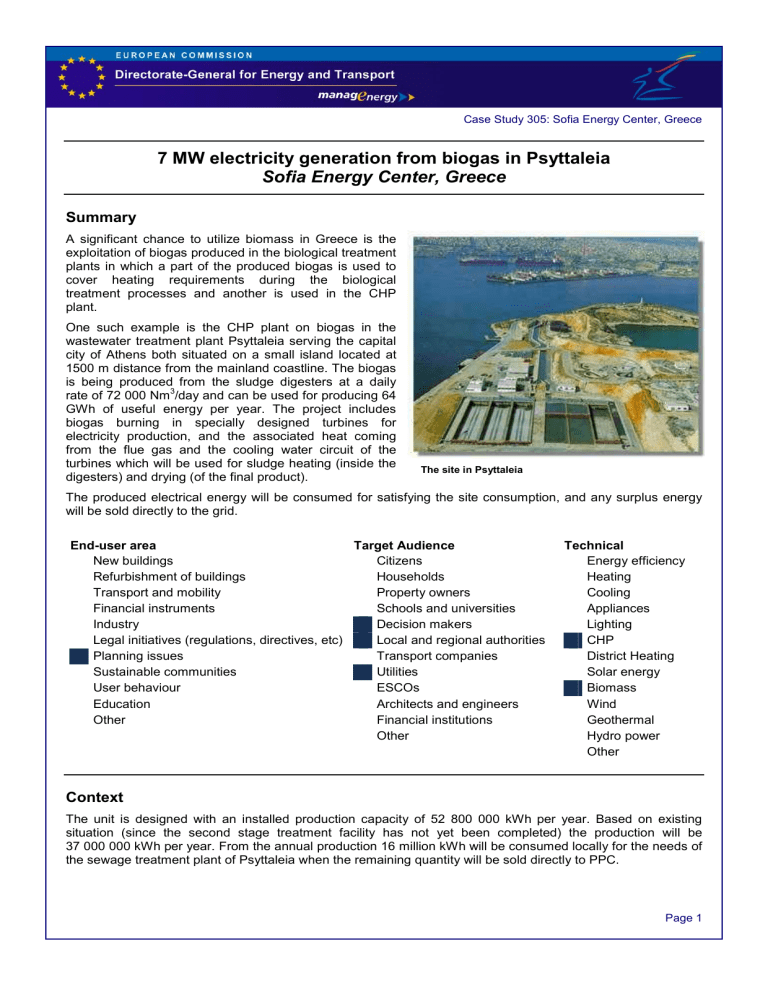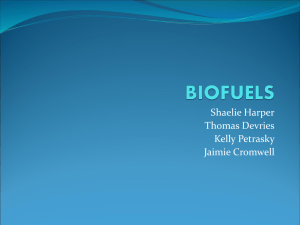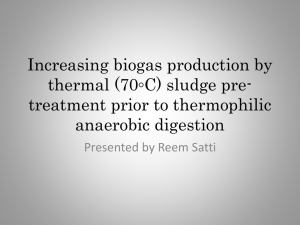7 MW electricity generation from biogas in Psyttaleia Summary

Case Study 305: Sofia Energy Center, Greece
7 MW electricity generation from biogas in Psyttaleia
Sofia Energy Center, Greece
Summary
A significant chance to utilize biomass in Greece is the exploitation of biogas produced in the biological treatment plants in which a part of the produced biogas is used to cover heating requirements during the biological treatment processes and another is used in the CHP plant.
One such example is the CHP plant on biogas in the wastewater treatment plant Psyttaleia serving the capital city of Athens both situated on a small island located at
1500 m distance from the mainland coastline. The biogas is being produced from the sludge digesters at a daily rate of 72 000 Nm
3
/day and can be used for producing 64
GWh of useful energy per year. The project includes biogas burning in specially designed turbines for electricity production, and the associated heat coming from the flue gas and the cooling water circuit of the turbines which will be used for sludge heating (inside the digesters) and drying (of the final product).
The site in Psyttaleia
The produced electrical energy will be consumed for satisfying the site consumption, and any surplus energy will be sold directly to the grid.
End-user area
New buildings
Target Audience
Citizens
Technical
Energy efficiency
Refurbishment of buildings
Transport and mobility
Financial instruments
Households
Property owners
Schools and universities
Heating
Cooling
Appliances
Industry Decision makers Lighting
Legal initiatives (regulations, directives, etc) Local and regional authorities CHP
Planning issues
Sustainable communities
Transport companies
Utilities
District Heating
Solar energy
User behaviour
Education
Other
ESCOs
Architects and engineers
Financial institutions
Other
Biomass
Wind
Geothermal
Hydro power
Other
Context
The unit is designed with an installed production capacity of 52 800 000 kWh per year. Based on existing situation (since the second stage treatment facility has not yet been completed) the production will be
37 000 000 kWh per year. From the annual production 16 million kWh will be consumed locally for the needs of the sewage treatment plant of Psyttaleia when the remaining quantity will be sold directly to PPC.
Page 1
Case Study 305: Sofia Energy Center, Greece
Objectives
The project aims at maximising the energy use of the biogas produced from treating the whole quantity of the daily wastewater production of the city of Athens (4 000 000 inhabitants) leading both to environmental and economic effects.
Process
Biogas is being produced from sludge treatment inside the digesters with a relative constant heating value. The overpressure of the biogas is only 20-30 mbars and hence biogas compressor units must be used in order to raise the gas pressure to 3,5 bars, which is the required pressure for use in gas turbines. Three WAUKESHA
12 cylinder supercharged gas reciprocate machines have been installed each one operating at 1000 rpm. The nominal power output is 2 900 KVA and the output voltage is 3,3 kV. The rejected heat from the turbine cooling water circuit is being used for supplying extra heat to the sludge digesters and hence it is improving the overall system efficiency. In addition the flue-gas leave the gas turbine chambers has a temperature of 400 °C and the heat content of that stream will be used in the near future for sludge dewatering and drying thus reducing humidity content and minimising its volume.
When the whole system will become operational an overall system efficiency of 80% will be realised.
Nevertheless the heat requirements for sludge heating at the digesters are not constant but follow a seasonal variation. An extra cooling circuit using sea water and a heat exchanger has also been installed in order to remove the heat surplus available at the hot water circuit.
The existing site substation (20KV) is being used for supplying power to the site and also for connecting the plant substation (3,3KV/20KV) to the national grid through a sub-water power cable.
Financial resources and partners
The total budget of the scheme is 11 113 720 Euro, with EU funding (Operational Program for Energy,
Community Support Framework 1994-1999 for Greece) 5 556 860 Euro and EYDAP S.A. ( ΕΥ∆ΑΠ ) 5 556 860
Euro.
Results
The environmental benefits arising from the realisation of this project are significant in terms of air emission reduction. The daily methane (CH emissions from 120 Nm 3
3 to 0,2 Nm
4
3
) emissions will be reduced from 20 000 Nm
3
to 0,2 Nm
when carbon monoxide (CO) will be held below 650 mg/m 3
3
, hydrocarbons
and NO x below
500 mg/ m . In addition to the reduced or avoided air emissions a significant reduction of solid wastes volume will be realised as dewatering and sludge drying will help in reducing its volume by a factor of 0,8. Currently the sludge is being deposited to Athens main landfill at Liosia, which is facing significant capacity problems. The project will also create 20 new jobs on site contributing hence to the acute unemployment problem of the wider area.
Lessons learned and repeatability
During the design and construction phase a number of issues have been raised which are briefly described below. At the early stages of the project significant issues arose as this was the first power plant of that kind ever installed in Greece and in addition the nominal power output was quite significant. The solution given was to send EYDAP personnel abroad to UK and Denmark where they had accumulated experience from existing similar type power plants. The location of the power plant and the wastewater treatment facility is quite unique as they are both situated on a small island located at 1500 m distance from the mainland coastline. Although part of the electrical energy production is consumed locally for the site needs, the energy surplus, which is a significant part of the overall production, is sold to the grid. This itself created a significant technical barrier, which had to be overcome namely the construction of an underwater cable connecting the island with the grid at the mainland and the associated control system. A under water cable connection was constructed with an
XLP insulated 355 cable and a second one 3 × 120 with paper insulation. Initially a small building was constructed on the island containing the hardware necessary for system control, and in addition for coupling and synchronising the generation facility with the grid. At a later stage PPC (the Public Power Company which
Page 2
Case Study 305: Sofia Energy Center, Greece was at that time the grid sole owner and supervisor) requested a second similar facility to be constructed at the mainland; a request, which was also fulfilled from EYDAP. PPC also constructed a cable connection between a nearby combined-cycle natural gas fed power plant and the control centre located at the mainland which made possible to control the whole island based generation system from distance (i.e. the system is now fully automated and unmanned).
Contact for more information:
Project Web Site:
Organisation / Agency: EYDAP-Akrokeramos Keratsiniou
Main contact: Moraitis I.
Tel: +30 210 7495834
Fax: +30 210 7495829
Page 3



